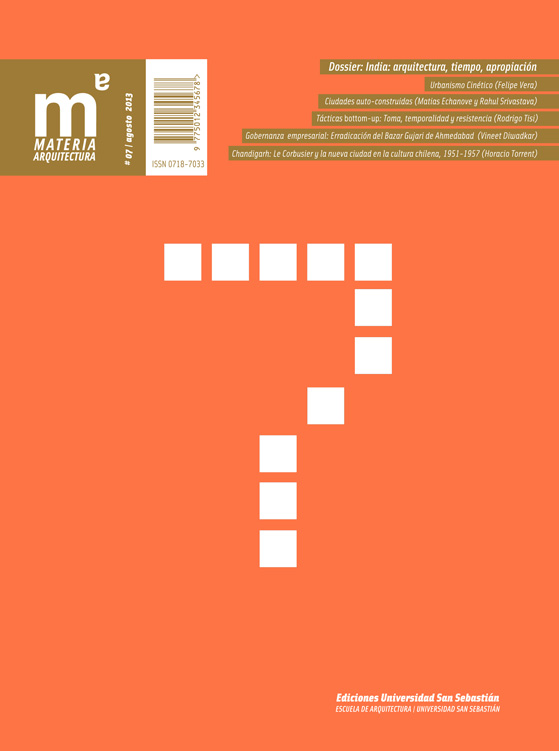Kinetic Urbanism. An alternative imagination for the urban practice
Article Sidebar
Keywords:
Main Article Content
Abstract
has progressively acquired more agency that “Static Density” in the transformation of the urban space. Coming out of a tradition that
has been developed with the focus in understanding legible and permanent urban morphologies, western urbanism has developed
an imagination inspired in the hard city. This has left a gap in what refer to the understanding of open ended processes associated
to softer urban tissues. This article discusses Rahul Mehrotra s notion of the Kinetic City, as an interpretation of Indian cities urbanism
arguing that such concepts and ideas are that useful also for addressing problems in the realm of design and planning outside the
Indian subcontinent.
Article Details
Materia Arquitectura provides immediate and free access to all the content of this online edition, published simultaneously with the print edition.
Materia Arquitectura does not charge authors for any concept.
All contents of this electronic edition are distributed under the Creative Commons license of "Attribución-shareAlike 4.0 Internacional" (CC-BY-SA).
The rights of the published texts and images belong to their authors, who grant Materia Arquitectura the license for their use. The management of the permits and the authorization of the publication of the images (or of any material) that contains copyright and its consequent rights of reproduction in this publication is the sole responsibility of the authors of the articles.
As long as they mention their origin, the authors are free to distribute their articles by other means. Any total or partial reproduction of the material must mention its origin.
Downloads
References
BISHOP, P. & Williams, L. (2012). The Temporary City. Abingdon: Routledge.
COHEN, P. & Naginski, E. (2010). Return To Nature. En M. Mostafavi & G. Doherty (Eds.), Ecological Urbanism (págs. 136 -137). Baden: Lars Muller.
FORMAN, R. (2008). Urban Regions: Ecology and Planning beyond the City. Nueva York: Cambridge University Press.
INGBER, D. (2010). Bio Inspired Adaptive Architecture and Sustainability. En M. Mostafavi & G. Doherty (Eds.). Ecological Urbanism (págs. 136 -137). Baden: Lars Muller.
KOOLHAAS, R. (1995). Whatever Happened to Urbanism. En R. Koolhaas & B. Mau, S, M, L, XL (págs. 959 – 971). Nueva York: Monicelli.
KOOLHAAS, R. (2004). Preservation is Overtaking Us. Future Anterior, 1(2, otoño), 1-3.
MATHUR, A. (1999). Neither Wilderness nor Home: The Indian Maidan. En J. Corner (Ed.), Recovering Landscape, Essays in Contemporary Landscape Architecture. Nueva York: Princeton Architectural Press.
MEHROTRA, R. (2008). Negotiating the Static and Kinetic Cities: The Emergent Urbanism of Mumbay. En A. Huyssen (Ed.), Other cities, Other worlds: Urban imaginaries in a Globalizing Age (págs. 205 -218). Durham, NC: Duke University.
MOSTAFAVI, M. & LEATHERBARROW, D. (1993). On Weathering: The Life of Buildings in Time. Cambridge: MIT Press.
NORA, P. (1989). Between Memory and History: Les Lieux de Mémoire. Representations (26, primavera), 7-24.
OXMAN, N. & ROSENBERG, J. L. (2007). Material-based Design Computation: An Inquiry into Digital Simulation of Physical Material Properties as Design Generators. International Journal of Architectural Computing (IJAC), 5(1), 26-44.
WALDHEIM, C. (2006). Landscape as Urbanism. En C. Waldheim (Ed.). The Landscape Urbanism Reader (págs. 35 -54). Nueva York: Princeton Architectural Press.
WIGLEY, M. (2001). Network Fever. Grey Room (04, verano), 82–122.
ZHONGJIE, L. (2010). Kenzo Tange and the Metabolist Movement; Urban Utopias of Modern Japan. Nueva York: Routledge.
Most read articles by the same author(s)
- Felipe Vera, Urbanismo Cinético. Una imaginación alternativa para las prácticas urbanas , Materia Arquitectura: No. 07 (2013): Materia Arquitectura 07 (Agosto/August 2013)
